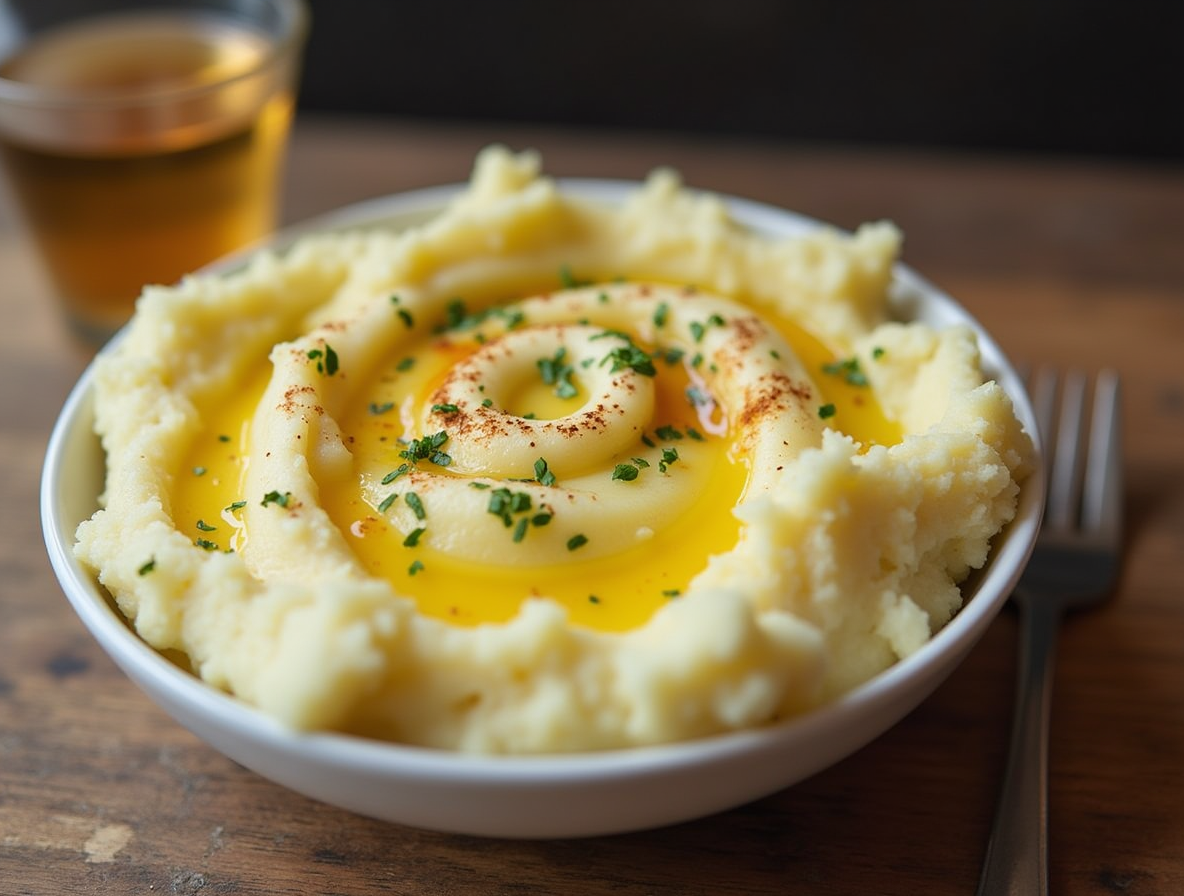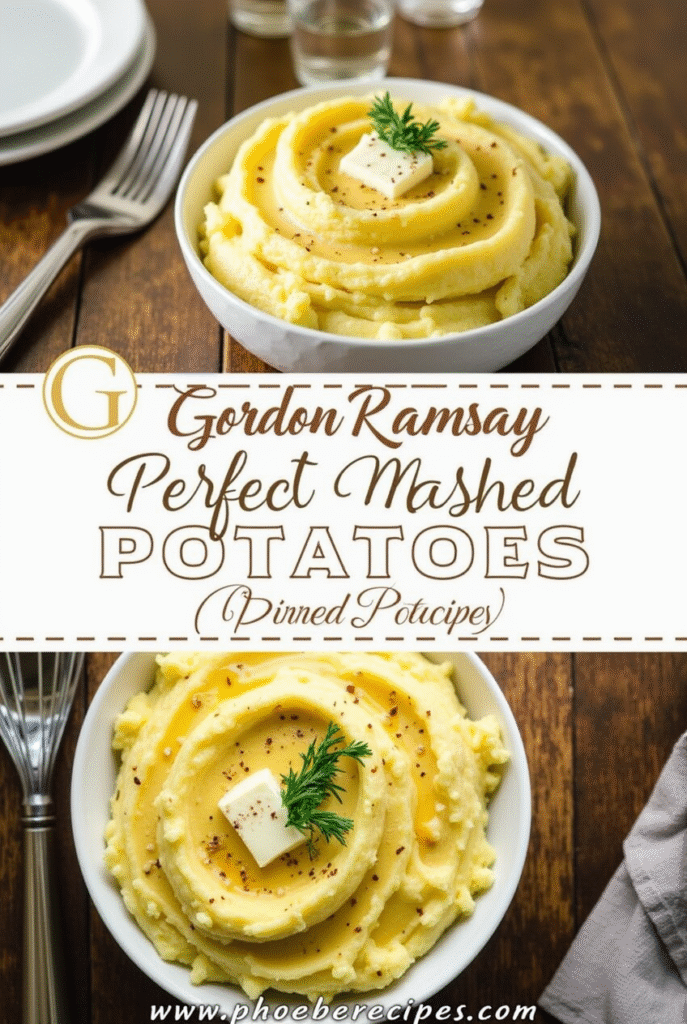Gordon Ramsay’s Secret to Perfect Mashed Potatoes (Chef’s Guide)
Gordon Ramsay mashed potatoes have earned their reputation as some of the most luxurious, creamy side dishes you can make at home. While many of us have prepared this comfort food classic, the difference between good and extraordinary mashed potatoes often comes down to technique.
What does Gordon Ramsay put in his mashed potatoes? Certainly, the 75g of melted salted butter and 240ml of hot milk or cream contribute to their velvety texture. However, it’s his methodical approach—using Russet or Yukon Gold potatoes, letting them steam-dry for 2 minutes after draining, and avoiding over-mixing—that truly elevates this dish. In fact, you can create these perfect mashed potatoes in just 30 minutes, making them both quick and impressive.
Throughout this guide, we’ll explore the step-by-step process to achieve Ramsay’s rich, creamy, and buttery mashed potatoes. Additionally, we’ll reveal the common mistakes that lead to gluey or watery results, ensuring you achieve restaurant-quality mashed potatoes right in your kitchen.
What Makes Gordon Ramsay’s Mashed Potatoes So Special
The magic behind Gordon Ramsay’s exceptional mashed potatoes lies in his meticulous attention to three crucial elements. These techniques transform an ordinary side dish into a silky, luxurious accompaniment worthy of a Michelin-starred restaurant.
The role of hot dairy and butter
Temperature stands as the cornerstone of Ramsay’s mashed potato philosophy. Unlike many home cooks who add cold milk and butter, Ramsay insists on heating these ingredients first. This seemingly small detail makes a remarkable difference in the final texture.
When you add hot dairy to cooked potatoes, the starch molecules remain open and receptive. Consequently, they absorb the fat more effectively, creating that velvety consistency Ramsay is famous for. Furthermore, heated butter distributes more evenly throughout the potatoes, eliminating those unpleasant cold spots that can occur with room-temperature butter.
Ramsay’s precise technique involves warming the milk or cream separately while melting the butter completely before incorporation. This approach ensures every bite delivers consistent creaminess and rich flavor.
Why potato type matters
Not all potatoes perform equally when mashed. Ramsay specifically recommends Yukon Gold or Russet potatoes for distinct reasons:
Yukon Gold potatoes contain the ideal balance of starch and moisture. Their naturally buttery flavor and creamy texture make them perfect for luxurious mashed potatoes with minimal effort. Meanwhile, Russet potatoes offer a fluffier texture due to their higher starch content, though they require more fat to achieve the same richness.
Ramsay strictly avoids waxy potatoes like Red Bliss or fingerlings as they develop a gluey, paste-like consistency when mashed. The science behind this comes down to cellular structure – starchy potatoes break down more readily, allowing for that cloud-like texture we crave.
The importance of gentle mashing
Perhaps the most underappreciated aspect of Ramsay’s technique is his gentle approach to mashing. Overworking potatoes releases excessive starch, transforming your side dish into something resembling wallpaper paste.
Ramsay advocates using either a potato ricer or a food mill for initial processing, followed by gentle folding with a spatula or wooden spoon. This method preserves the potato’s cellular integrity while incorporating the fat and dairy.
The chef emphatically warns against using food processors or blenders, which tear through potato cells aggressively. As he often demonstrates, the perfect mash requires patience and a delicate touch – qualities that distinguish professional results from amateur attempts.
By respecting these three fundamental principles, anyone can recreate Ramsay’s signature mashed potatoes at home, elevating this comfort food classic to restaurant-quality heights.
Step-by-Step: How to Make Perfect Mashed Potatoes Gordon Ramsay Style
Now let’s roll up our sleeves and make these legendary potatoes! Following Gordon Ramsay’s precise technique will transform your humble spuds into a silky masterpiece. This straightforward process takes about 30 minutes from start to finish.
1. Choose the right potatoes (Russet or Yukon Gold)
Start with selecting the proper potatoes – this is non-negotiable. Russets create a fluffy, light texture, whereas Yukon Golds deliver a naturally creamier, buttery result. Avoid waxy varieties at all costs as they produce gluey results. Peel your potatoes and cut them into even-sized chunks (about 2 inches) to ensure uniform cooking.
2. Boil in salted water with garlic
Place your potato chunks in a pot of cold salted water along with a few garlic cloves. Starting with cold rather than boiling water helps the potatoes cook evenly from inside out. Bring to a boil, then reduce to a simmer and cook with the lid on for approximately 15 minutes until fork-tender – the fork should slide through with zero resistance.
3. Drain and steam-dry the potatoes
Once cooked, thoroughly drain the potatoes in a colander. Subsequently, return them to the hot pot (off the heat) and let them sit uncovered for 1-2 minutes. This crucial steam-dry step allows excess moisture to evaporate, preventing watery mash and creating fluffier results.
4. Add melted butter before mashing
Incorporate the melted butter first, before any other ingredients. This clever technique coats the starch molecules, preventing them from becoming gluey when you add the liquid. Work quickly – the hotter the potatoes during this process, the fluffier your final result.
5. Slowly mix in hot milk or cream
Separately heat your milk or cream (with butter if desired) in a small saucepan until gently simmering. Pour this hot mixture gradually into the potatoes while gently mashing. This temperature harmony prevents the shock of cold dairy hitting hot potatoes, which would negatively affect texture.
6. Season and serve hot
Finally, season generously with salt and pepper to taste. Mix well but don’t overwork. Serve immediately while piping hot – not warm, hot! Ramsay insists this timing detail makes a noticeable difference in the final experience.
Common Mistakes That Ruin the Texture
Even experienced home cooks can fall prey to common pitfalls that transform potentially perfect mashed potatoes into disappointing disasters. Understanding these mistakes is essential to achieving Gordon Ramsay’s signature creamy texture.
Using cold milk or butter
One critical error that instantly compromises texture is adding refrigerated dairy products to hot potatoes. Cold milk and butter not only cool down your potatoes prematurely but also fail to absorb properly into the starch structure. According to culinary experts, cold liquid simply cannot soak into hot potatoes effectively, forcing you to mix longer and harder to incorporate ingredients.
Instead, heat your milk or cream until steaming and bring butter to room temperature (or melt it) before adding to potatoes. This simple temperature adjustment allows the dairy to be absorbed much more easily, maintaining the potato’s integrity while minimizing handling.
Overmixing the potatoes
Potatoes contain significant amounts of starch – approximately 85% of their solid matter. When potatoes are overworked, excessive starch releases, creating that dreaded gluey, elastic texture that resembles wallpaper paste.
To avoid this texture disaster, limit how much you handle the potatoes after cooking. Mix gently and only until ingredients are incorporated – never vigorously or for extended periods. Once the potatoes become smooth and creamy, stop immediately.
Skipping the steam-dry step
After draining boiled potatoes, many cooks immediately start mashing. This oversight introduces excess water into your mash, resulting in a soupy, diluted texture.
The solution is remarkably simple: after draining, return potatoes to the warm pot over low heat for about 5 minutes. This crucial drying period allows excess moisture to evaporate, creating a drier foundation that better absorbs butter and cream. For truly exceptional results, gently turn the potatoes occasionally to ensure they don’t stick to the pot.
Using the wrong tools (like a blender)
Perhaps the most devastating mistake is processing potatoes with high-powered equipment. Despite seeming like a shortcut to smoothness, food processors and blenders actually destroy the potato’s cellular structure, releasing torrents of starch almost instantly.
As professional chefs emphatically warn, these appliances transform potatoes into a sticky, gummy paste. Instead, opt for a potato ricer or food mill for initial processing, followed by gentle folding with a spatula. If these tools aren’t available, a traditional masher works adequately with proper technique – just never a blender!
Pro Tips and Variations from Gordon Ramsay
Beyond the basic techniques, Gordon Ramsay offers several expert tips and creative variations to elevate your mashed potatoes into something truly extraordinary. These professional touches make all the difference between good and exceptional results.
Use a ricer for ultra-smooth texture
The humble potato ricer stands as Ramsay’s secret weapon for achieving restaurant-quality smoothness. Unlike standard mashers, a ricer processes potatoes in a single pass, minimizing starch activation. Moreover, this tool allows you to leave the skins on during boiling since they’ll stay behind in the ricer chamber. As professional chefs attest, “A ricer is something that can’t be replicated or replaced. It mashes potatoes into a texture that’s uniquely silky and entirely free of lumps”.
Infuse milk with herbs or garlic
Rather than adding herbs directly, Ramsay recommends infusing your dairy first. Simply heat milk or cream with whole garlic cloves, bay leaves, rosemary, or thyme, then strain before adding to potatoes. Ramsay considers this infused cream “the varnish of the dish,” adding silkiness and nuanced flavor without compromising texture. For optimum results, use young garlic with small cloves as they’re less harsh than mature ones.
Add sour cream or crème fraîche for tang
For a pleasant acidity that cuts through richness, Ramsay suggests substituting half the milk with sour cream or crème fraîche. This simple adjustment adds complexity without sacrificing creaminess. Additionally, some chefs incorporate Greek yogurt for another layer of flavor.
Try truffle oil or Parmesan for luxury
For special occasions, Ramsay elevates his mash with truffle paste and oil. Importantly, add truffle oil as a finishing touch rather than cooking it in—this preserves its aromatic qualities. Alternatively, fold in freshly grated Parmesan cheese for a savory umami boost.
Rest the mash before serving
Surprisingly, allowing your finished mashed potatoes to rest for 2-3 minutes before serving yields superior results. Throughout this brief rest, “the butter settles and the mash stabilizes”, creating a more harmonious final texture.
Conclusion
Mastering Gordon Ramsay’s mashed potato technique certainly transforms an everyday side dish into a culinary masterpiece. Throughout this guide, we’ve seen how seemingly small details make extraordinary differences in the final product.
The perfect mash starts with choosing starchy potatoes like Yukon Gold or Russet. Additionally, heating your dairy before adding it allows for better absorption and creamier results. Most importantly, gentle handling prevents the dreaded gluey texture that ruins many home attempts.
Common pitfalls become easy to avoid once you understand the science behind them. Cold dairy, excessive mixing, skipping the steam-dry step, and using high-powered appliances all destroy the delicate structure that creates that restaurant-quality texture.
Professional touches like using a ricer, infusing your milk with aromatics, or adding a dollop of crème fraîche elevate your potatoes from merely good to genuinely exceptional. These simple yet effective methods demonstrate why Ramsay’s approach stands apart.
You might find this method slightly more involved than throwing everything together, but the results speak for themselves. Thirty minutes of attentive cooking rewards you with silky, luxurious potatoes worthy of a Michelin-starred restaurant. Your family and guests will undoubtedly notice the difference—though they might not realize the professional techniques behind your newfound potato mastery.
Ramsay’s perfect mashed potatoes prove that classic comfort foods deserve the same careful technique as fancy cuisine. After all, these aren’t just side dishes—they’re opportunities to transform the ordinary into something truly memorable.
FAQs
Q1. What’s the secret to making restaurant-quality mashed potatoes at home? The key is using starchy potatoes like Russet or Yukon Gold, adding hot dairy and melted butter, and gently mashing to avoid overworking the potatoes. Also, letting the potatoes steam-dry after boiling helps achieve a fluffier texture.
Q2. Why does Gordon Ramsay recommend using hot milk or cream in mashed potatoes? Hot dairy helps the potatoes absorb fat more effectively, resulting in a creamier texture. It also ensures even distribution of butter and prevents cold spots in the final dish.
Q3. What’s the best tool for mashing potatoes according to Gordon Ramsay? Ramsay recommends using a potato ricer or food mill for the smoothest texture. These tools process potatoes without overworking them, which can lead to a gluey consistency.
Q4. How can I add extra flavor to my mashed potatoes? Try infusing the milk or cream with herbs or garlic before adding it to the potatoes. You can also incorporate sour cream or crème fraîche for tanginess, or add truffle oil or Parmesan cheese for a luxurious touch.
Q5. What’s the biggest mistake people make when preparing mashed potatoes? Overmixing is a common error that releases too much starch, resulting in a gluey texture. Other mistakes include using cold dairy, skipping the steam-dry step after boiling, and using high-powered appliances like blenders or food processors.


